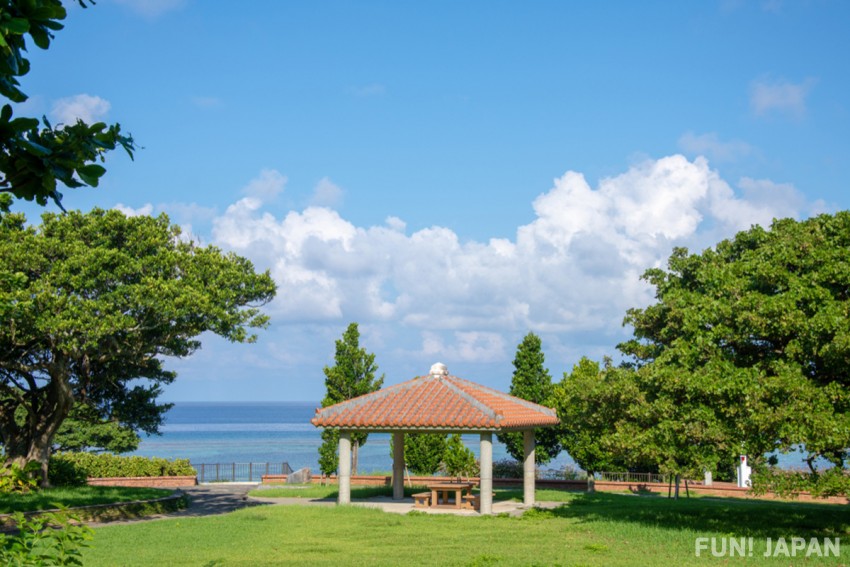
Okinawa was once the site of the Battle of Okinawa, but now it is one of the best tourist destinations in Japan, located on the southwestern edge of the Japanese islands.
Okinawa's main island, the tourism centre, is abundant with natural attractions such as sightseeing spots, mangrove and beaches. In addition, remote islands such as the Yaeyama Islands have lots and lots of beautiful beaches and you can experience marine activities there.
About Okinawa
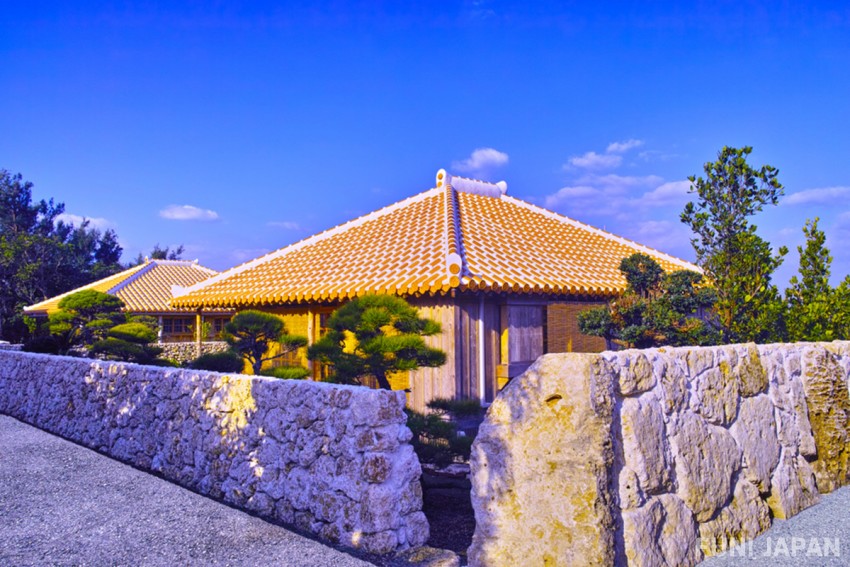
Okinawa prospered as the “Ryūkyū Kingdom” in the 15th - 19th centuries, and it has a history of developing its own culture. There are still lots of historical buildings on the main island of Okinawa.
Also, traditional culture such as traditional performing arts like dances, folk songs, and traditional crafts such as pottery and dyed fabrics remains strong.
The Main History of Okinawa
The history of Okinawa is unique and deep. Its history dates all the way back to the 15th century, beginning with the Ryukyu Kingdom. As an ocean nation, it developed via trade with mainland China, Southeast Asia, and Japan. Although it had formed its own culture, it became Japanese territory in the 19th century and changed from the Ryukyu Kingdom to the Okinawa Prefecture.
Later, after being governed by the U.S. military, Okinawa was reborn in the 1970s as a sightseeing spot where the current mix of various cultures occurred. Currently, it is one of Japan's top tourist destinations where more than 3 million foreigners visit Japan annually.
What is the Okinawa Shisa?

Shisa figurines can be seen everywhere in Okinawa. Shisa is a word from Okinawan dialect, meaning lion. A Shisa is a guardian deity which looks like a lion. It is said that a pair of male and female Shisa will chase away monsters when placed on top of a roof or gate.
Miniature sized Shisa figurines and key chains are also popular as souvenirs.
Things that should be Known before Sightseeing in Okinawa
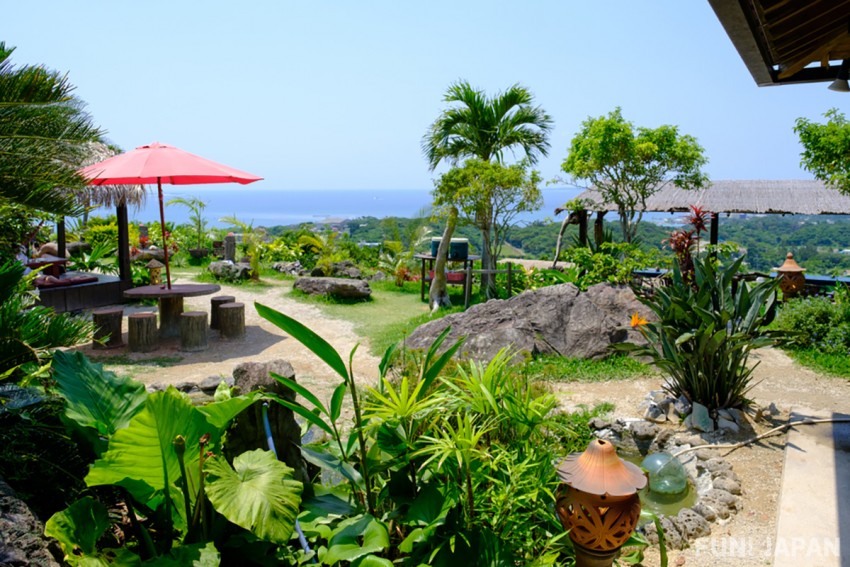
Before going sightseeing in Okinawa, it is useful to be aware of the locations of tourist information centres and places where foreign currency can be exchanged. It is also a good idea to take a sightseeing map of Okinawa, which has a wide area of land, particularly when planning your itinerary
What is the Best Itinerary for Okinawa?
The best itinerary in Okinawa depends on the area that you go to. The sightseeing area of Okinawa large and there are many spots to go to. Broadly speaking, there are three main areas: the Okinawa main island, the islands around the Okinawa main island and the remote islands. The main island of Okinawa is divided even further into the Nanbu (southern), Chubu (central) and Hokubu (northern) areas.
For example, if you just plan to visit the main island of Okinawa, it is necessary to stay for at least two nights and three days. However, if you can afford it, It is recommended to spend 3 nights or more.
As well as the time spent going to sightseeing spots scattered through the southern, central and northern areas, it takes time to move between the areas, so it is better to spend one day for each of them.
If you plan to head to a remote island, it is good to add one or two extra nights.
Where can a Tourist Map of Okinawa be Obtained?
A tourist map of Okinawa can be obtained at tourist information centres. There are three tourist information centres in Okinawa, one at the international and domestic terminals of Naha Airport. Another one is located at the Naha Bus Terminal. In addition, there is a tourist information centre in Naha City situated on Kokusai-dori.
Furthermore, some tourist associations as well as commercial and industrial associations also distribute maps and pamphlets to visitors.
If you wish to get a tourist map in advance rather than when you get to your destination, it can be downloaded from "Okinawa Inbound net." which is a website operated by the Okinawa Tourism Convention Bureau (OCVB). The available languages are English, Chinese (simplified), Chinese (traditional), Korean, and Thai.
Where can Money be Exchanged in Okinawa?
Currency exchange in Okinawa can be done at various places, including currency exchange machines and walk-in counters at banks, currency exchange shops, and hotels.
If you need to exchange currency immediately after arriving in Okinawa, drop by the arrival lobby on the first floor. There are automatic exchange machines as well as manned counters.
In addition, if you need to change money while sightseeing, please use the service from a bank, currency exchange shop, or hotel. If you want to go to a bank, the Bank of Okinawa and the Bank of The Ryukyus are the most convenient. For instance, the Bank of Okinawa has installed a total of 28 foreign currency exchange machines at their headquarters, and tourist and commercial facilities throughout the prefecture. The Bank of the Ryukyus in contrast, does not handle many currency types, but they offer foreign currency exchange at 74 branches.
Other foreign currency exchange shops include EIGHT EXCHANGE, which has six branches in the prefecture, and the Edoya Exchange Center, which has two branches. (Information accurate as of February 2020)
The Climate and Temperature and Highlights in Okinawa
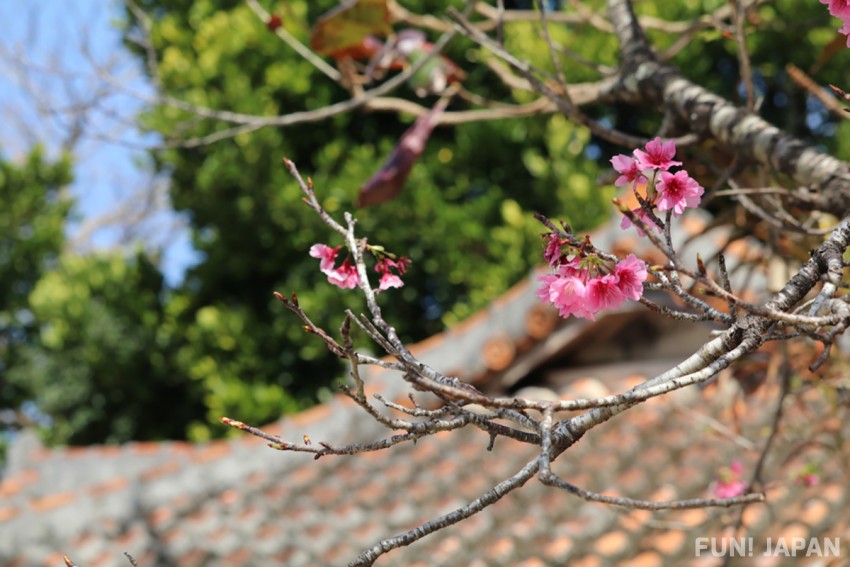
The climate in Okinawa Prefecture is warm and humid throughout the year with little difference in temperature. One of the characteristics of the weather in Okinawa’s tourist spot, Naha, is the short sunshine hours but with large rainfall. Typhoons in Okinawa are common from August to September, and they come around seven times a year.
The weather of Okinawa changes throughout the day, and even on a clear day, it can rain much like a squall. Therefore, it is better to check weather forecast apps frequently such as Weather Japan as well as weather forecasts on TV. Since Okinawa has a lot of UV rays all year round, be sure to take UV protection even on cloudy days and in winter.
Spring in Okinawa (March - May )
One characteristic of the spring weather in Okinawa is that it changes every few days. The weather in Okinawa in April is the best, with days that have temperatures of around 20 ° C.
Until around March, it is possible to go whale watching in various locations so be sure to check it out.
This is the season of sakura (cherry blossoms) in Honshu (the main island of Japan, but it should be noted that cherry blossoms in Okinawa bloom from January to February, so cherry blossom viewing is not possible during this season.
Summer in Okinawa (June - August )
Summer in Okinawa begins in mid-June, after the rainy season has pasted. Although it is a humid season, days with the maximum temperature exceeding 35 °C is much less than in Honshu.
In summer, there is an abundance of events, like summer festivals and festivals where lots of people dance the "Eisa".
Autumn in Okinawa (September - November)
September is considered as early autumn on the Japanese calendar but the summer heat continues in Okinawa. In November, the temperature finally drops, and the continent gets cold and there are more cloudy days.
Another major difference from Honshu is that people can still take a dip in the sea until around October. Additionally, autumn leaves such as maple cannot be seen in Okinawa. However, you can see the red-dyed spectacular sight of the plant called Hazenoki tree (wax tree).
Winter in Okinawa (December - February)
The temperature in Okinawa rarely drops below 10 °C even in winter. The weather from December to January is more often cloudy and rainy due to the monsoon. As the effective temperature drops, it is better to take measures against the cold, such as wearing coat or thick clothes.
The highlight of winter is the sakura (cherry blossoms). In Okinawa, the sakura bloom from late January to early February. A variety of dark pink sakura called kanhizakura (Prunus campanulata) colour the city. The sakura in Nago City are famous.
Additionally, from January to March is the season for whale watching.
Main Sightseeing Areas in Okinawa

There are three major tourist areas in Okinawa. The main island of Okinawa is long from north to south, there are islands dotted as though surrounding the main island, and the islands spread southwestern of the main island. The Okinawa main island is further divided into the Nanbu (southern), Chubu (central) and Hokubu (northern areas).
| Sightseeing Area | Features |
| Southern area of main island of Okinawa | The gateway to Okinawa where Naha Airport is located and an area with World Heritage Sites. |
| Central area of main island | An area with a wide range of sightseeing attractions from the American Village to Yakitori no Sato |
| Northern area of main island | An area abundant with nature, surrounded by tropical forests. |
| Remote Islands surrounding the main island | Islands situated in the northeastern area of the Okinawa Prefecture. A mysterious area with islands that have historic sites and islands of worship |
| Remote Islands (Archipelego) | Remote Islands (Archipelego) Areas where the wilderness remains, such as islands with endemic species and natural monuments |
Food & Restaurants in Okinawa
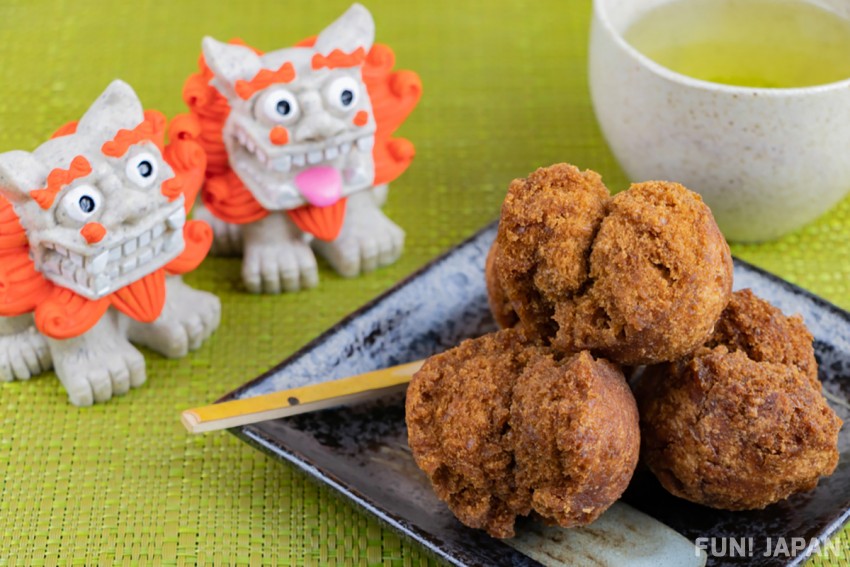
Famous food in Okinawa includes local dish using Okinawa soba and island vegetables. You can eat both Okinawan soba and other local dishes, with different local arrangements in each area. There is also a restaurant in Naha that serves court cuisine which reproduces the meals of King Ryukyu.
There are lots of restaurants in Naha City, particularly in Kokusai-dori, a street that runs between Okinawa City Monorail Kencho-mae Station and Asato Station.
Okinawa Soba
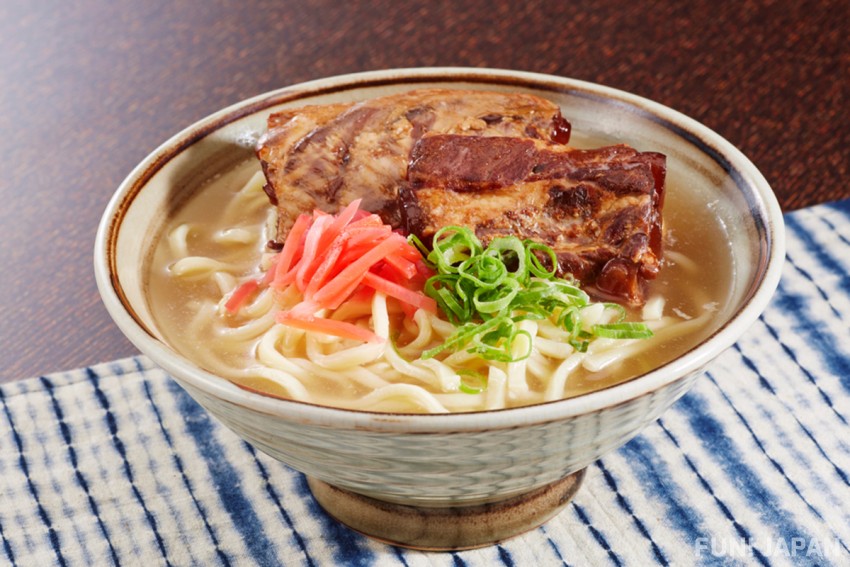
Okinawa soba is the soul food of the Okinawan people. Authentic Okinawa soba has a specific description such as using raw materials and the thickness of noodles. If these specifications are met, it can be claimed to be Okinawa soba. The main ingredients are kamaboko, island green onions, and stewed pork etc, but the soup flavour and ingredients vary by region.
There are shops where Okinawa soba can be eaten in various parts of the prefecture, but famous ones include "Ishigufu (いしぐふー)", which has branches in each area, and "Kishimoto Shokudo (きしもと食堂)" in Motobu, which has a history of over 100 years.
Goya Champuru
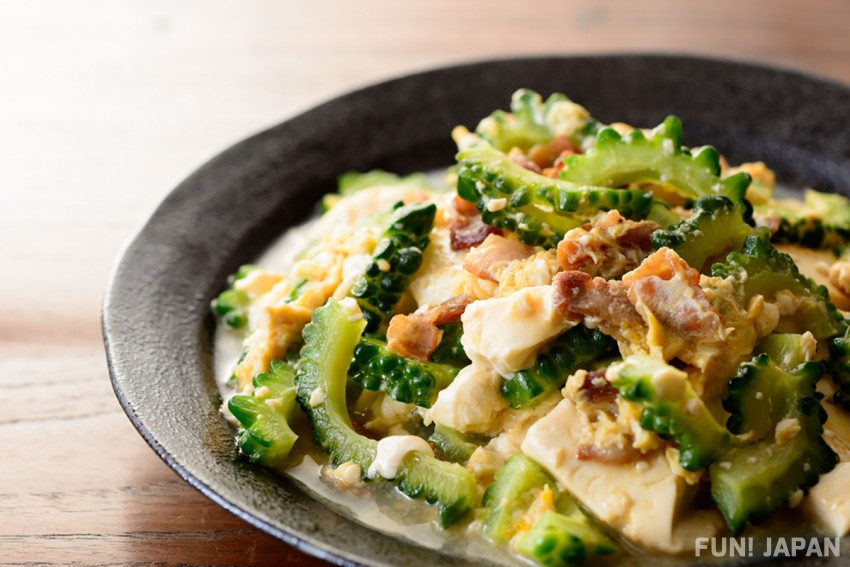
Goya Champuru (ゴーヤチャンプルー) is home cooking that represents Okinawa. It is a dish of stir-fried goya, a type of vegetable, and island specialty tofu, it is delicious with its slightly bitter taste.
It is served in various places like local restaurants, pubs and hotels within the prefecture.
Taco Rice

Taco rice (タコライス) is a local dish born in Okinawa. It is the Mexican dish tacos on white rice, and is presently eaten at home and school.
A famous taco rice shop is King Tacos Kin Honten in Kin Town, that inherited taco rice from the restaurant where taco rice was born. This is a popular restaurant that many tourists visit, so be sure to stop by!
Okinawa Cafes
Okinawa has unique cafes all around the prefecture. For instance, there is a variety of photogenic cafes and cafes with fantastic scenery.
At each store, cakes made with Okinawan fruits and pizza made with plenty of vegetables can be eaten. Among them, Cafe ichara in Motobu is a hidden away cafe located in a primeval forest, where freshly baked pizza is its specialty.
Awamori
Awamori (泡盛) is local sake that is made in Okinawa. In contrast to sake that uses white rice and malted rice, it is characterized by being brewed with Thai rice and black rice malt.
There are lots of breweries in the northern and southern areas of the main island of Okinawa and the Yaeyama Islands. Awamori can be drunk at regular izakaya (Japanese store), but there are also unique vending machines that have 18 kinds of awamori such as “GURUMAW (ぐるまーう)'' and unique stores such as the izakaya “ASAMADEYA (朝まで屋)” where awamori comes out if you twist the tap.
Accommodation in Okinawa
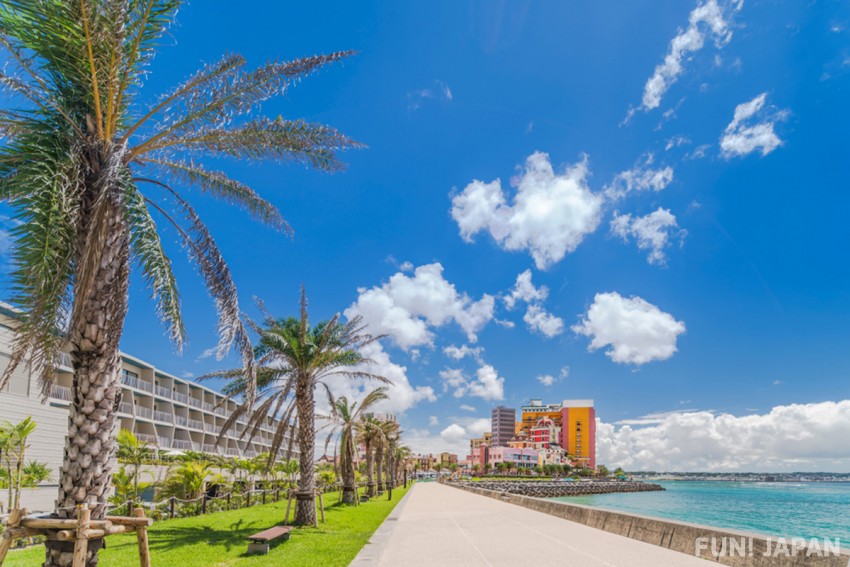
There are lots of accommodation facilities in Okinawa, from large resorts to guest house. Here, we have made a summary of information regarding accommodation.
Hotels in Okinawa
Okinawa has different types of hotels depending on the area. Below you will find the information for each area.
| Sightseeing Area | Features |
| The Southern Area (Nanbu) | Abundant with urban economy hotels |
| The Central Area (Chubu) | A wide area from guesthouses to resorts available |
| The Northern Area (Hokubu) | Area with lots of high-brand resort hotels |
| The remote islands around the main island | Small hotels such as petit hotels are most common |
| Kume Island | Large resorts and guesthouses only |
| Kerama Islands | An area with accommodation that has diving shops |
| Miyako Islands | Lots of villa style hotels available |
| Yaeyama Islands | An area with a wide variety of accommodations such as Glamping, luxury resorts, guest houses |
Famous Resorts in Okinawa
There are lots of Okinawa resorts in the northern section of the main island. For instance, luxury brand resorts such as "The Ritz-Carlton Okinawa," "Hyatt Regency Seragaki Island Okinawa," and "ANA Intercontinental Manza Beach Resort" are available.
Others famous ones include "Hiramatsu Hotels & Resorts Ginoza" under Hiramatsu, which operates a nationwide restaurant chain.
Guesthouses and Hostels in Okinawa
There are lots of Okinawa guesthouses and hostels on islands besides the main island. There is also accommodation attached to diving shops.
In addition, there are lots of airbnb accommodations on the main island of Okinawa. Outside the main island, there are around 170 on Miyako island. The average price is around 5,000 yen in Naha city, but it is about 1,000 - 65,000 yen in other areas depending on the location and room type. (Information accurate as of February 2020)
Access Information of Okinawa Prefecture
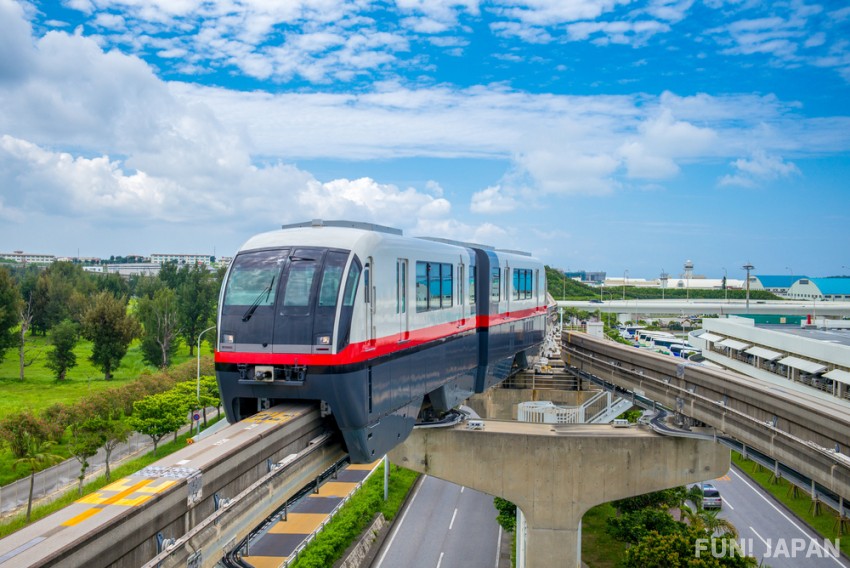
Okinawa is dotted with islands and there are various modes of transportation. Here, we will summarize how to move within the prefecture.
Use the Monorail, Bus and Taxi on the Main Island
The main transportation on the main island of Okinawa is bus. Route buses can be used to go around almost the entire island. In Naha city, the monorail that passes around Kokusai-dori or Shuri Castle is much more convenient than using bus.
If you wish to go to a specific sightseeing spot, we recommend using a sightseeing taxi, which is guided by the driver or a tour guide.
If you would like to travel freely from the south to the north of the main island, it is possible to take a rental car. There are lots of rental car shops around Naha Airport.
Airplane, High-speed Ferry or Boat is Convenient for Getting to the Remote Islands!
You can access to remote islands of Okinawa via plane or boat. High-speed ferry is convenient for access between the main island and remote islands, as well as that within the remote islands.
It is better to fly from Naha airport to the islands that have airports. Here, we will describe the access from Okinawa’s main island to various places.
| Island name | Transportation | Required Time |
| Kume Island | Plane (Kume Island Airport) Ferry (Kanegusuku Port) | About 35 minutes About 3 ~ 3.5 hours |
| Kerama Islands | Express boat or Ferry (Zamami Port) | About 50 minutes or 2 hours |
| Miyako Islands | Plane (Miyako Airport) | About 55 minutes |
| Yaeyama Islands | Plane (Okinawa to Ishigaki airport) | About 1 hour |
Access to Okinawa and Flights Information
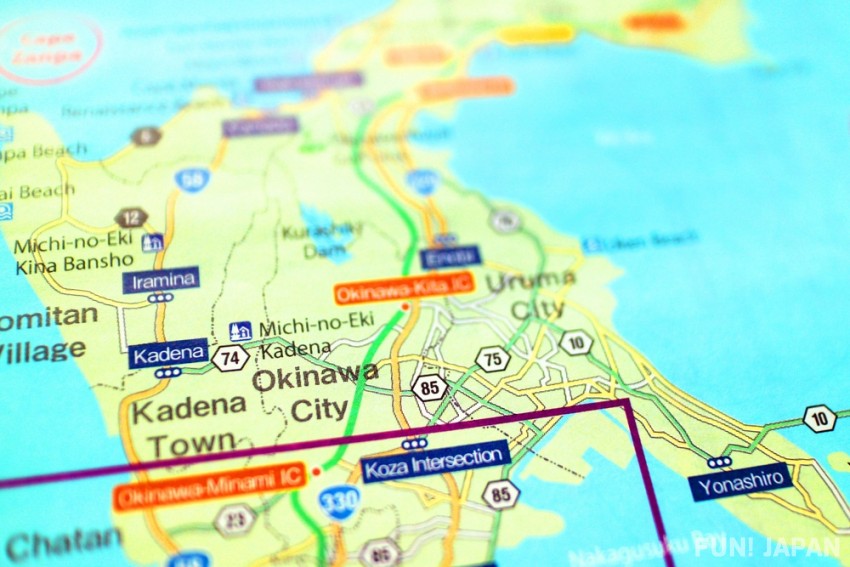
To go to Okinawa, please head to Naha airport. There are direct flights in Naha Airport from other prefectures in Japan and all over the world. Here, we have summarized the flight information from Japan and overseas.
Domestic Flights
In Japan, there are regular domestic flights from other airports to Naha Airport. We have summarized access from major airports.
| Major Airport | Requied Time |
| Hokkaido (Shin-Chitose Airport) | About 4 hours |
| Tokyo (Haneda Airport) | About 3 hours |
| Osaka (Kansai International Airport/ Osaka International Airport) | About 2.5 hours |
| Fukuoka (Fukuoka Airport/ Kita Kyushu Airport) | About 1 hour and 45 minutes |
It is accessible to Okinawa in about 4 hours, even from Hokkaido, the farthest. In addition, it can be reached in about 3 hours from Tokyo where many international flights are in service, so it is convenient to go through Tokyo depending on the flight.
International Flights
There are international flights to and from 15 cities. Here, we summaries the flights from major cities.
| Main City | Required Time |
| Taiwan (Taipei / Taichung / Kaohsiung) | About 1 hour 25 minutes - 1 hour 55 minutes |
| Hong Kong | About 2 hours 20 minutes - 3 hours |
| Singapore | About 5 hours |
| Seoul | About 2 hours 20 minutes |
| Shanghai | About 2 hours – 2.5 hours |
Among these, flight numbers from Taiwan are substantial. There are three cities that are served, and most flights that come in are from Taipei. Other countries have limited flight days and numbers of flights, but the access environment is not so bad.



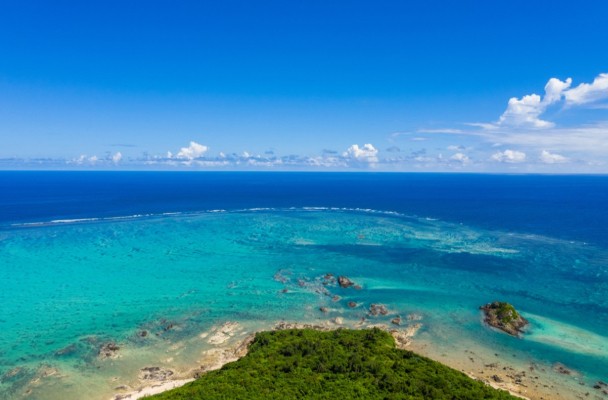

Comments